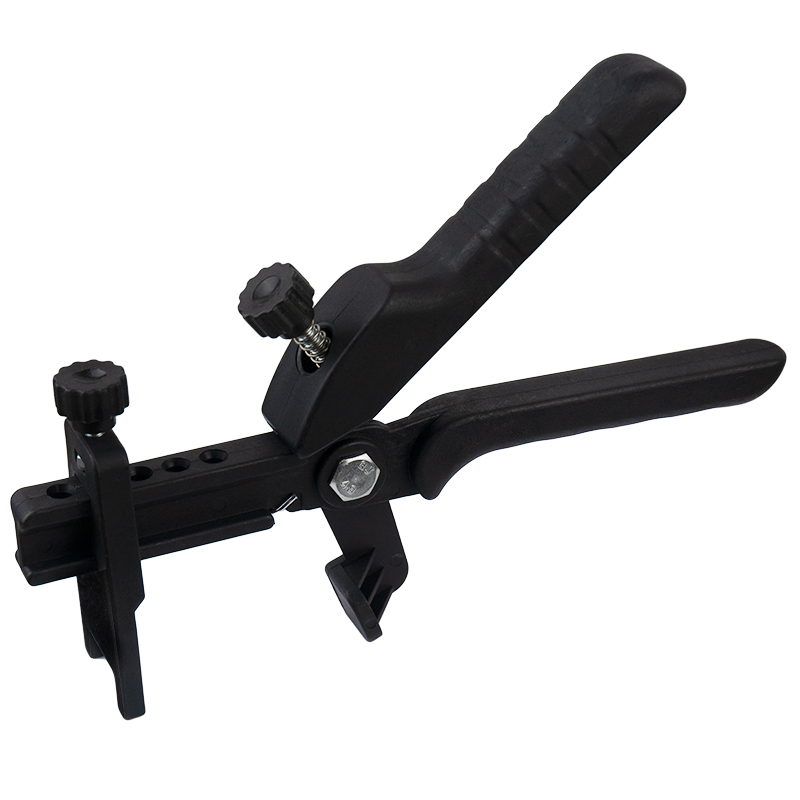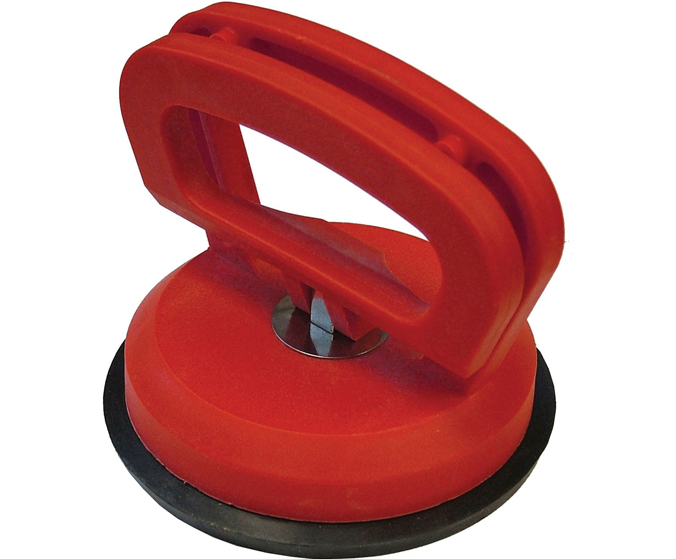Tile Leveling System Pliers (plastic)
Description
Tile Leveling System Pliers (plastic)
The operation of locking the wedge inside the aligned clip is done by a tool called pliers or an aligned wrench. The parallel wrench is made of fiber-reinforced polyethylene or a combination of plastic and metal and has one fixed jaw and two movable jaws.

Properties
- It causes the tiles to be installed and aligned accurately and harmoniously.
- It has a long life and can be used repeatedly.
- It increases the speed of tiling.
packing
Vacuum 1 number
Product Description – Leveling Pliers (Leveling Pliers)
Tile and ceramic levelers are used to level tiles and ceramics during installation. Flat tile levelers are the most widely used type of tile and ceramic levelers, which are produced and offered in several sizes. Flat tile levelers consist of two pieces: a clip and a wedge. The clip is disposable, but the wedge can be used multiple times. The clip is placed between the tile or ceramic interface, and the wedge, as a locking and leveling piece, completes the tile installation by entering the gap in the clip. The operation of locking the wedge inside the leveling clip is performed by a tool called pliers or leveling wrench. The leveling wrench is made of fiber-reinforced polyethylene or a combination of plastic and metal and has one fixed jaw and two movable jaws. After placing the leveling wedge into the slot in the leveling clip using pliers, the wedge is locked into the clip to the maximum extent that it can enter the clip slot (based on the thickness of the tile, ceramic or parquet), and the locking and engagement with the clip is fixed by the treads embedded on the surface of the leveling wedge.
Metal wrenches are of better quality than plastic wrenches, so if you use the leveler in small quantities and for a project, plastic pliers are very suitable, but if you are a master tile and ceramic worker or use the leveler for many projects, metal leveling pliers will definitely be much more efficient. The tile and ceramic leveler makes the installation of tiles and stones faster and more orderly. Finally, using tile leveling equipment results in a uniform and smooth surface at the end of the work.
Tile leveling pliers are a practical tool in tiling that is used during the installation of tiles. This tool can help tile installers install tiles on a uniform and coordinated level with the help of leveling pieces, which are made of durable plastic materials. This wrench is designed in such a way that by placing it in the place of the clamps, you can compress them and fix the tiles on the same level. It also allows the installation of tiles to be done more accurately and prevents unwanted gaps in the surfaces.
Consumption of parallel wrenches (parallel pliers)
Level wrench usage
What is the consumption rate of a parallel key?
The flush wrench is designed and manufactured from two types of durable fiber-reinforced plastic and metal, which, if properly maintained, can remain a permanent tool in the tiler’s toolbox forever.
Parallel key tips (parallel pliers)
Ceramic tile leveling wrench tips
What are the essential tips when using a tile and ceramic leveling wrench?
- Depending on the size of the alignment, first adjust the distance between the jaws of the alignment wrench. To adjust the distance, slowly move the movable jaw closer to the fixed jaw and test on the pliers or alignment wrench until you reach the desired size.
- After finishing work with the leveling wrench, thoroughly clean any cement or mortar stains left on the pliers or leveling wrench.
- Make sure that after working with the leveling pliers, there are no cement or mortar stains left on the threads of the screws or nuts, as this will make adjustment operations difficult in subsequent uses.
- To remove cement stains, you can use cement cleaner with metal tools.
How to use a parallel wrench (parallel pliers)
How to use a ceramic tile leveling wrench
How to use a tile and ceramic leveling wrench?
The leveling wrench has one fixed jaw and two movable jaws. The movable jaws of the pliers or leveling wrench are produced in two sizes, one of which is for small leveling and the other is for large and medium leveling. According to the leveling size used, the appropriate jaw is selected and fixed in the appropriate place by the locking screw, and the other jaw is removed from the mechanism of the pliers or leveling wrench. Determining the distance between the movable jaw and the fixed jaw is very important. Because if the distance is too large, the leveling wedge inside the clip will not be completely locked, and if the jaws are close to each other, there is a possibility of breaking the clip or tile leveling wedge due to pressure applied during locking.
Tile Leveling System Pliers (Plastic)
Tile leveling system pliers are essential tools used in conjunction with tile leveling systems to ensure flatness and alignment across tiled surfaces. These pliers are specifically designed to lock the wedge into the clip, ensuring tight contact between tiles and preventing any lippage. Typically, the pliers are constructed from either high-strength plastic (often fiber-reinforced polyethylene) or a combination of plastic and metal for enhanced durability and ergonomic handling.
The design features one fixed jaw and two interchangeable movable jaws, allowing the user to adjust the grip depending on the size of the leveling system components. While plastic tile leveling pliers are ideal for occasional or residential use, professional tile setters often prefer the more robust metal versions for intensive and long-term use.
Properties
- Accurate Tile Installation
Ensures that each tile is aligned perfectly and remains flush with adjacent tiles, which eliminates uneven surfaces and improves the final aesthetic. - Increases Speed and Efficiency
By simplifying the wedge insertion and tightening process, these pliers significantly reduce installation time, especially for large tiling projects. - Durability and Reusability
Made from high-strength plastic, these pliers are built to withstand repeated use without deforming or wearing out. When maintained properly, they remain functional for a long time. - Ergonomic and Lightweight Design
Plastic tile leveling pliers are designed for comfortable, prolonged use without causing hand fatigue. Their lightweight construction is particularly beneficial on extended projects.
Packaging
- Vacuum-Sealed – 1 Piece per Pack
Supplied in single units, typically vacuum-packed for cleanliness and ease of storage. Ideal for both personal toolkits and professional supply inventories.
Product Description – Leveling Pliers (Plastic)
Leveling pliers, often called tile leveling wrenches, are integral to any tile leveling system. Their main role is to secure the wedge firmly inside the clip after it has been placed between adjacent tiles. The pressure applied via the pliers ensures tight contact, preventing displacement of tiles during the adhesive curing process.
Plastic leveling pliers are particularly well-suited for smaller-scale projects or occasional use. While metal alternatives offer higher mechanical strength and longevity, plastic versions are more cost-effective and perfectly sufficient for standard tile installation jobs.
The pliers feature:
- A fixed jaw that serves as the base.
- Two interchangeable movable jaws, one suited for smaller tile leveling systems and the other for medium-to-large formats.
By locking the wedge into the clip slot with appropriate pressure, the pliers guarantee consistent leveling, regardless of tile thickness or material. The wedge is held in place by teeth or treads on its surface, which grip the clip securely to maintain alignment until the adhesive sets.
Usage Guidelines and Best Practices
How to Use a Tile Leveling Wrench:
- Adjust the Jaw Size
Begin by determining the type and size of the tile leveling system being used. Select the appropriate movable jaw and attach it using the locking screw. Make sure the spacing between the jaws corresponds precisely to the clip and wedge dimensions. - Insert the Wedge into the Clip
After positioning the leveling clip between two tiles, insert the wedge into the clip slot manually until it holds loosely. - Tighten Using Pliers
Place the jaws of the pliers around the wedge and clip. Squeeze the handles gradually to push the wedge into the clip slot until firm resistance is felt. Avoid over-tightening, which could damage the clip or tile. - Post-Installation Cleaning
After use, clean the pliers thoroughly. Remove any mortar or adhesive residue—especially from moving parts and screw threads—to ensure smooth operation in the future. Cement cleaner or a mild solvent may be used for tough stains.
Tips for Efficient Use
- Proper Maintenance Prolongs Life
Clean after each use to avoid buildup that may affect the functionality of the jaws or screws. - Check Alignment Before Tightening
Always ensure the wedge and clip are aligned correctly before applying pressure. Improper alignment may cause damage or reduce leveling accuracy. - Avoid Excessive Force
Apply only the necessary amount of pressure to achieve a tight lock. Over-compression may result in broken clips or deformation of the wedge. - Select the Right Jaw Size
Switching between jaw sizes based on the leveling clip used ensures better control and minimizes the risk of breakage.
When to Choose Plastic vs. Metal Pliers
- Plastic Tile Leveling Pliers:
Suitable for DIYers, small renovation projects, or one-time use. They offer a cost-effective solution with satisfactory performance for light to moderate usage. - Metal Tile Leveling Pliers:
Recommended for professional contractors and frequent users. These are designed to endure high workloads and deliver consistent pressure without bending or wearing out.
In summary, tile leveling system pliers—particularly the plastic type—are invaluable tools for achieving smooth, flat, and visually appealing tiled surfaces. They simplify the leveling process, increase installation speed, and ensure long-lasting, professional results. With the right handling and care, even a plastic leveling plier can become a durable asset in any tile installer’s toolkit.






Reviews
There are no reviews yet.